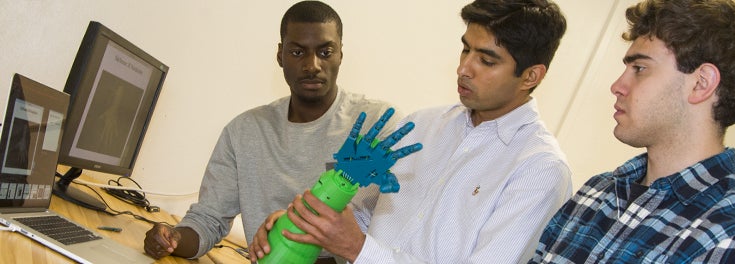
For the four million worldwide with Parkinson’s disease, a smart wristband invented by a team of URI engineering students could let them lead healthier lives. The wristband uses high-tech motion sensors to detect tremors in those with the disease, sending the information to doctors over a secure Internet connection. By measuring the effect of prescribed medications and the progression of the disease, it enables neurologists to make more informed decisions
This is one of many projects URI engineering students are working on to improve the lives of people with a wide range of diseases. Many of the projects are part of what Engineering Assistant Professor Kunal Mankodiya calls “the wearable Internet of things”—wearable technologies with built-in sensors to collect information about medical symptoms that can be transmitted to physicians via wireless technology. Professor Mankodiya is even teaching an undergraduate course on the subject this fall that will team biomedical, electrical, and computer engineering students to develop their own wearable medical devices.
With some creativity and engineering design, these technologies can revolutionize the future of health care.
The three students who invented the smart wristband garnered international attention for their device as one of 23 finalists at the recent International Undergraduate Global Health Technologies Design Competition in Houston.
“Wearable devices and smart phones are often looked at as unnecessary luxuries,” said Trevor Bernier, a May 2015 biomedical engineering grad, “but with some creativity and engineering design, these technologies can revolutionize the future of health care.”
The project to develop the device was also a valuable learning experience. “I learned a lot about all the different needs for technological innovations in medicine, especially in developing countries,” said sophomore Joe Tudino. “It’s made me think about the role of wearable technology and how the technology of the future will be small, subtle, and supplement our lives.”
Among the projects that students developed this year were “pulse glasses,” which incorporated a sensor embedded in the nosepad of a pair of eyeglasses that can monitor the wearer’s pulse. Another student team developed a smart watch system to monitor vital signs.
Junior Cody Goldberg was involved in almost all of the student projects by developing the entire technological framework for the wearable Internet of things. “It allows us to quickly whip up different devices that require cross-device communication,” he explained. “Instead of reinventing the wheel with every project, we developed an overall architecture that accelerates the projects pretty fast.
“Nobody should have to suffer from simple things when technology exists to make them better,” Cody added. “Combining these technologies will allow us to forget about the hindrances we endure and let us focus on the things we deserve.”
